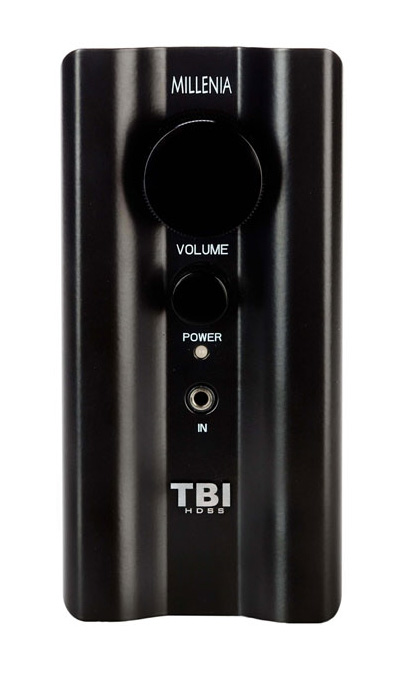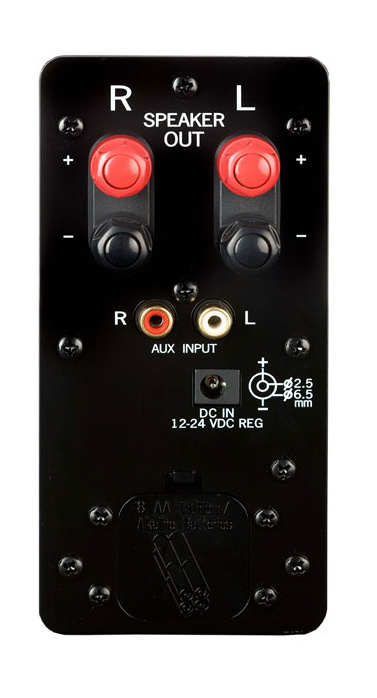|
|
You are reading the older HTML site
Positive Feedback ISSUE 67
tbi audio Millenia MG3 Gen 3 Amplifier as reviewed by John Hoffman
The landscape of Class D amplification is a shifting and ever changing field, where the technologies and parts that have been used in conventional amplifiers no longer automatically yield superior sound quality. This latest form of amplification creates a brave new world, where innovative thinking is needed to force a clean break from the past and cut a new path for music reproduction. In issue 62 of Positive Feedback Online, the TBI Millenia MG3 was introduced to readers. Then an update to the power supply brought about an incremental improvement in sound quality, which yielded a Writers Choice award for 2012. Earlier this year I received a call from Jan Plummer at TBI Audio, and he was enthusiastic about a series of upgrades that have been developed for the Millenia amplifier, which are significant enough to warrant rolling out a 2.0 version. The Millenia amplifier is a compact design that pays a great deal of attention to RFI and EMF patterns of interference, and how these fields compromise the audio signal in an amplifier. The signal path in this amplifier is extremely short, and the circuit layout takes advantage of new techniques and parts developed in the electronics manufacturing industry. The breakthrough that Jan has made on the Millenia amplifier concerns the use of a new generation of polyphenylene sulfide (PSS) capacitors in the input coupling stage of the amplifier. Traditional capacitor technology such as mylar, electrolytic, other types of film, or even Teflon have performance compromises related to either their dielectric characteristics or physical size. Which makes them a less than desirable option for use in the MG3 amplifier. Once the new capacitors were installed, Jan made slight adjustments to the inter-stage coupling stage, and tweaked the power supply circuit. The basic structure of the Millenia remains intact, and the amplifier price holds steady at $500. However, the improvement in overall sound quality is not subtle in nature. The TBI amplifier is capable of running on a both AC mains, and DC battery power. Running on the outboard AC power supply the amplifier is capable of producing 32 WPC. With 12 volt DC current the amplifier outputs 10 WPC Although if 24 volts of DC current can be accessed, the Millenia will also generate 32 WPC. For my listening sessions I run the amplifier in both power supply configurations, with a single 12 volt sealed lead battery for DC mode. Speakers are the Sachiko Double Horn from Frugal Horn, and contain first generation Fostex 208 Sigma drivers. The digital source is an Audio Magic Kukama DAC that is partnered with an Enlightened Audio Design T1000 transport. Zu Audio Mission speaker wire and VH Audio Spectrum CU interconnects make the connections in the system. An Audio Magic Mini Reference power conditioner supplies clean AC current to the source components, and the Millenia when being used with the AC power supply. The performance gap between my Electra Print amplifier and the Millenia amplifier has rapidly closed, as the latest cluster of improvements that Jan has devised for the TBI amplifier has effectively erased the largest flaws from the previous generation amplifier. Earlier versions of the MG3 amplifier had excellent sound quality for the price point, but there were always a sonic signature that was consistent with the Class D circuit design. Essentially, the music had a smooth and refined sound, but never could quite cross that threshold of realism that separated a SET, push-pull tube amp, or even a well executed solid state design from the chip amp contingent. The 2.0 version of the TBI amp has breached that meridian, and is a legitimate high performance amp that is within the financial reach of most any hobbyist. The first version of the Millenia sounded a slightly constrained and overly polite, while the 1.1 version removed a significant portion of this facade. The 2.0 series amplifier now dissolves several more sonic artifacts, and projects an honest rendition of the music into the room that makes an immediate connection with the listener. Over the years Mary Chapin Carpenter has logged a great many hours on my systems, and I find her music to be satisfying over the long haul, but also very well recorded. "John Doe No. 24" [Stones In the Road; Columbia CK 64327] is a long time reference, and the Millenia turns in a performance that is worthy of an affordable high end amplifier. Carpenter is located well out into the room with an immediacy that brings out the subtle texture of her dark and introspective vocal style. Her guitar playing has a languid pace, and you can just close your eyes and see her fingers work over each string, and slide across the neck in a an unhurried pace. Branford Marsalis is responsible for the poignant saxophone work on this song, and while the instrument is located farther back in the sound stage, it has such compelling tone and texture that it cannot be ignored. Marsalis closes the song with a melancholic solo, and the saxophone has such a vibrant feel to it that all the emotion he places in this passage flows out to the listener. The Millenia now has the ability to affect an emotional connection between artist and audience, and that is a rare trait that separates the pedestrian consumer grade level of electronics from what the hobbyist would consider to be higher performance audio gear.
Feed the Millenia amplifier with battery power, and you will uncover where the real mojo is hidden. When run on straight DC, the MG3 becomes slightly darker, with a laid back tonal balance that is seductively inviting. I suspect there are certain characteristics of the Class D design that will have a inherent influence on the music. This by itself is not by any means an objectionable occurrence, for any affordable amplifier is going to imprint its character onto the music to a certain degree. John Gorka is an elder statesman in the modern folk movement. His compositions typically has a warm and rich tonal balance, and a velvety feel that adds a tactile dimension to the music for the listener to experience. "The Mercy Of The Wheels" [Jack's Crows; High Street Records 72902 10309-2] illustrates the point that the Millenia can possess warmth, texture, and refinement, and not get to the point where the natural tone of instruments and vocalists are lost. In the past I have encountered amplifiers that would make an acoustic stew of this song by stamping their own romantic character to the mix, which thankfully the Millenia does not engage in this type of behavior. Gorka's acoustic guitar work often reaches into the lower registers, and the guitar body resonances are an integral part of his technique. There is a proper balance to this instrument, and while it does have a dark and introspective feel, it still comes across as being a realistic presentation. Gorka rarely demonstrates a wide vocal range in his work, but he is so adept with inflection that his style communicates a great degree of emotion and feeling. The Millenia amplifier certainly conveys the important aspects of his vocal abilities, and does not cover up the emotional nuances by being overly smooth and refined. Vocals are deep and resonant, with that underlying degree of roughness that adds a distinctive flavor to Gorkas's style. Pairing the Millenia with the AC power supply in place of the battery pack will add weight and authority to the music, but at the expense of the remarkable transparency this amp is capable of on DC power. The increase of power output for this integrated gives the music a greater physical presence, in terms of both volume and dynamic impact. There is more to this attribute than sheer volume, for when the music requires dynamic swing and contrasts, the MG3 is capable of delivering the goods. With the PSS capacitor upgrade in place, the 2.0 version out paces its predecessor in the areas of detail and clarity, and has all the benefits that increased output will deliver. On "Mountain Cry" by Blues Traveler [Travelers and Thieves; A&M Records 75021 5373 2] the harmonica has a metallic sheen to go along with the brash texture that defines the instrument. Subtle stick work on the cymbals is still well defined, while drum strikes project from the back of the sound stage. The extra power on tap means that the bass guitar and kick drum have a tactile presence, and demand that the listener acknowledge and pay attention to what these instruments contribute to the music. John Poppers vocals are gritty, with a gravelly undertone that just exudes all the emotion and feeling that the blues can communicate. Listening to Blues Traveler, Jeff Healey, Johnny Lang, or Kenny Wayne Sheppard is a great way to spend an evening with the Millenia, and I stayed up late one night running all these artists through this amplifier. The PSS capacitor upgrade, and associated changes, for the Millenia amplifier is the real deal. The previous version of this amplifier was a very solid product, and offered genuine value for the dollar spent. Jan Plummer should be given kudos for continuing to refine this product and holding the price steady, instead of creating a SE version and adding an up-charge due to improved performance. What does this mean for owners of earlier versions of the MG3? Actually, Jan can retrofit all the upgrades of the new version of this circuit into the previous generation machines for $50 plus shipping charges. From my perspective this is a remarkably affordable upgrade, and the improvement in sound quality is a worthwhile investment. The Millenia 2.0 excels at projecting music into a room, and the midrange region has such a believable texture and tone. This amplifier also has an uncanny expression of dynamic contrast that is very rare at this price point. While packing only 32 WPC, if paired with the right speakers the TBI amplifier is capable of creating a satisfying rendition of scale to large ensemble performances. The previous amplifier was an unbridled success at the $500 price point, yet the Millenia 2.0 version sets the bar even higher for affordable Class D amplification. Any hobbyists working on a modest budget should give this amplifier a listen to, for it is one of the hidden gems in the audio landscape. John Hoffman
Millenia MG3 Gen 3 Integrated Amplifier
TBI Sound
|









